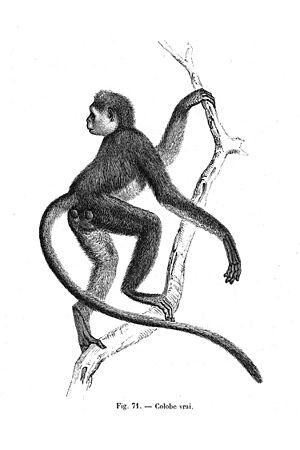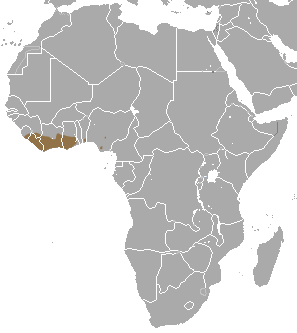Olive colobus facts for kids
Quick facts for kids Olive colobus |
|
|---|---|
 |
|
| Conservation status | |
| Scientific classification | |
| Genus: |
Procolobus
|
| Species: |
verus
|
 |
|
| Olive colobus range | |
The olive colobus monkey (Procolobus verus), also known as the green colobus or Van Beneden's colobus, is a type of primate that lives in trees. It belongs to the monkey family called Cercopithecidae. Its name comes from its dull olive-colored fur on its upper body.
This monkey is the smallest of all the colobine monkeys. It's quite hard to spot in the wild because its colors help it blend in. It also tends to be very shy. You can find the olive colobus in the rain forests of West Africa, from southern Sierra Leone all the way to Nigeria. The IUCN Red List says the olive colobus is a vulnerable animal. This means its numbers are going down because of habitat loss and hunting. Even though humans have changed much of its home, it can still survive in small parts of damaged forests.
Contents
About the Olive Colobus
The olive colobus is a small monkey. Males usually weigh about 4.6 kilograms (about 10 pounds). Females are a bit smaller, weighing around 4.1 kilograms (about 9 pounds). Their fur is greenish-brown. The hairs are yellowish-green at the bottom and get darker towards the tips.
The fur on their underside is lighter. The hairs on their face are stiff and dark. Their special coloring helps them hide in the trees. This makes it harder for predators to find them. Like other colobine monkeys, the olive colobus has a very small thumb on its front feet. However, their back feet still have five toes. Their feet are also quite large compared to other African colobus monkeys.
What Do Olive Colobus Monkeys Eat?
Olive colobus monkeys live in different types of forests. These include new growth areas in tall forests, palm forests, and swamps. They usually find their food in the lower and middle parts of the trees. The olive colobus mainly eats leaves, especially young ones.
They might also eat fruits and seeds when they can find them. They tend to avoid older, tougher leaves. This is because they have a special stomach that helps them digest leaves. They need to eat very high-quality food. Because of their unique digestion, they don't eat many fruits that are very acidic. Too much acid can harm the tiny living things in their stomach that help them digest food.
How Olive Colobus Monkeys Live
The olive colobus monkey is a very shy and secretive animal. This makes it hard for scientists to watch and understand their behavior. We do know that their social life is quite complex. Olive colobus monkeys live in small groups. These groups usually have a few breeding males, several females, and their babies.
Even though they live in small groups, olive colobus monkeys are almost always seen with other monkeys. They often hang out with the Diana monkey, Cercopithecus diana. Scientists think this friendship helps the olive colobus in many ways. One big benefit is that it helps them avoid predators. For example, olive colobus monkeys are more willing to go higher into the treetops to eat when other monkey species are nearby.
Being close to Diana monkeys also helps male olive colobus monkeys find new female mates. The way olive colobus monkeys mate is special. Unlike many animals that live in small groups, the males don't seem to control all the females. It's thought that females use their mating behaviors to limit how much control males have. This can give females more choices in who they mate with. It also helps reduce the risk of males harming babies. Plus, it might mean more fathers help care for their young.
Protecting the Olive Colobus
The olive colobus monkey is in danger because its home is shrinking. Hunters and farmers are moving into both protected and unprotected forest lands. To help protect this threatened species, the olive colobus is listed under Appendix II of CITES. This is a global agreement that watches the international trade of animals and plants. It's also listed as a Class A species under the African Convention on the Conservation of Nature and Natural Resources.
Many protected areas help the olive colobus. One important place is Taï National Park in the Ivory Coast of West Africa. This park was made a Forest and Wildlife Refuge in 1926. It became a special biosphere reserve in 1982. The park is very large, covering 330,000 hectares (about 815,000 acres). It also has a 20,000-hectare buffer zone where new farms and settlements are not allowed.
Even with these efforts, illegal farming and hunting are still big threats to the olive colobus. To make sure these monkeys survive, stronger laws and rules are needed. Also, more education and public awareness programs would help. Learning more about the olive colobus through study and observation will also be important for its future.


